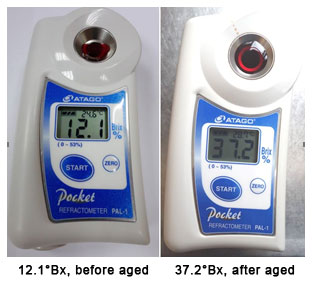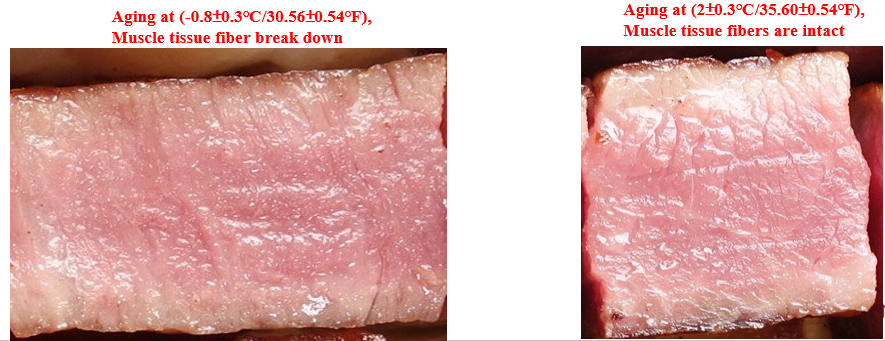Digital Sweetness Meter
Digital Sweetness Meter
-
The amino acids and sweetness of the aging beef will change during dry aging process.
-
To carry out amino acid analysis of aging beef in certified laboratory is very expensive.
-
The alternative easy way to determine the degree of meat texture change in aging beef is to measure the sweetness of the beef during aging process. The degree of sweetness of different grade beef also varies. The sweetness of the Prime grade beef is definitely better than the Choice grade beef.

Picture 14: Handheld Digital Sweetness Meter measures the sweetness (°Bx) of the beef during aging process.
6 SGS FOOD LAB-TAIPEI Test Report: 18 free amino acids in dry aged ribeye beef processed by King Son Convertible IFP Aging Chiller
| Report No. | FA/2018/B2100A-01 | FA/2018/C1344A-01 | FA/2018/C1345A-01 | FA/2019/10735A-01 | FA/2019/10736A-01 | FA/2019/14721A-01 |
|
Amino Acid |
Without dry |
IFP dry aging for 30 days (-0.8±0.3℃ / 30.56±0.54℉), 75% R.H. |
IFP dry aging for 30 |
IFP dry aging for 42 |
IFP dry aging for 42 |
IFP dry aging for 42 |
|
Aging |
days (2±0.3℃ / 35.60±0.54℉), 60% R.H. |
days (-0.8±0.3℃ /30.56±0.54℉), 75%R.H. |
days (2±0.3℃/35.60±0.54℉) , 80% R.H. |
days (-0.8±0.3℃ /30.56±0.54℉), 80%R.H. |
||
|
Alanine |
9859 |
14205 |
14462 |
11022 |
11074 |
13872 |
|
Arginine |
10529 |
15948 |
16114 |
11121 |
11094 |
15919 |
|
Aspartic Acid |
16006 |
22094 |
22253 |
16068 |
16436 |
22051 |
|
Cystine |
1219 |
2034 |
2071 |
1631 |
1780 |
2346 |
|
Glutamic Acid |
27927 |
39160 |
39203 |
28666 |
29289 |
39680 |
|
Glycine |
8059 |
9738 |
10188 |
7453 |
7996 |
14271 |
|
Histidine |
7561 |
9736 |
9979 |
6206 |
6754 |
8324 |
|
Isoleucine |
8737 |
12821 |
13095 |
8942 |
8575 |
11575 |
|
Leucine |
13708 |
19248 |
19070 |
13677 |
13932 |
18195 |
|
Lysine |
15921 |
22905 |
23398 |
16931 |
17618 |
22706 |
|
Methionine |
5160 |
6292 |
6457 |
4650 |
4572 |
6593 |
|
Phenylalanine |
7167 |
9727 |
9947 |
7113 |
7171 |
9949 |
|
Proline |
7341 |
8668 |
9842 |
7346 |
7131 |
11084 |
|
Serine |
6288 |
8300 |
8706 |
6257 |
6413 |
7947 |
|
Threonine |
4894 |
8940 |
9208 |
5332 |
5537 |
8052 |
|
Tyrosine |
5797 |
7504 |
7818 |
4902 |
5207 |
7621 |
|
Valine |
8058 |
11642 |
11733 |
8008 |
8266 |
10848 |
|
Tryptophan |
1800 |
2593 |
2631 |
1752 |
1845 |
2298 |
|
Total |
166031 |
231555 |
236175 |
167077 |
170690 |
233331 |
|
42 days aging
|
Aging at (-0.8±0.3℃ / 30.56±0.54℉), 80%R.H.
|
Aging (2±0.3℃/35.60±0.54℉), 80%R.H.
|
|
Sweetness Brixº
|
42.5 Brixº , [2 times than beef aged at (2±0.3℃/35.60±0.54℉), 80%R.H.]
|
21.0 Brixº
|
|
Total amount of amino acid
|
233331, [about 1.5 times than beef aged at (2±0.3℃/35.60±0.54℉), 80%R.H.]
|
170690
|
|
Aging aroma
|
Butter aroma after aged
|
Meat flavor rich
|
|
Profile appearance
|
Muscle tissue fiber break down
|
Muscle tissue fibers are intact
|
|
Aroma after cooking
|
The fragrance of the Mena reaction is mild
|
The fragrance of the Mena reaction is richer (the rate of aging increases
|
|
by 25% for every 1 °C / 1.8℉ increase in temperature)
|
||
|
Sweetness
|
Aged beef taste sweet obviously
|
The sweetness that produced in beef aged at (2±0.3℃/35.60±0.54℉), 80%R.H. is less than aging at (-0.8±0.3℃ / 30.56±0.54℉), 80%R.H.
|
|
Mouthfeel
|
Dry aging enhances palatability of beef
|
More chewing
|
|
Tasty, worth keep trying
|
Yes
|
Just once
|
|
Conclusions
|
The best aging flavor and effect at (-0.8±0.3℃ / 30.56±0.54℉), 80%R.H.
|
Recommend heavy tasters to have aging beef at (2±0.3℃/35.60±0.54℉), 80%R.H.
|
Beef source: American Prime Ribeye Beef (Sweetness 14.4% before aging)

Picture 15: The profile comparison of 42 days aging beef by different temperature
It is well known that muscle is converted to meat as food during postmortem aging. Meat flavor as well as texture are improved during postmortem aging. The improvement of meat taste in flavor is involved in the increase in free amino acids and peptides in meats during postmortem aging. Especially, the increase in free amino acids is thought to contribute to the enhancement of brothy taste including umami, while the increase in peptides is responsible for giving mildness. The increase in peptides is caused by the action of cathepsins B and L, and calpains on muscle proteins, while the increase in free amino acids is caused by the action of aminopeptidases C, H and P on the peptides during postmortem aging.
(Source:
-
Mechanism Involved in the improvement of Meat Taste during Postmortem Aging
-
Toshihide NISHIMURA, Department of Food Science, Faculty of Applied Biological Science, Hiroshima University

